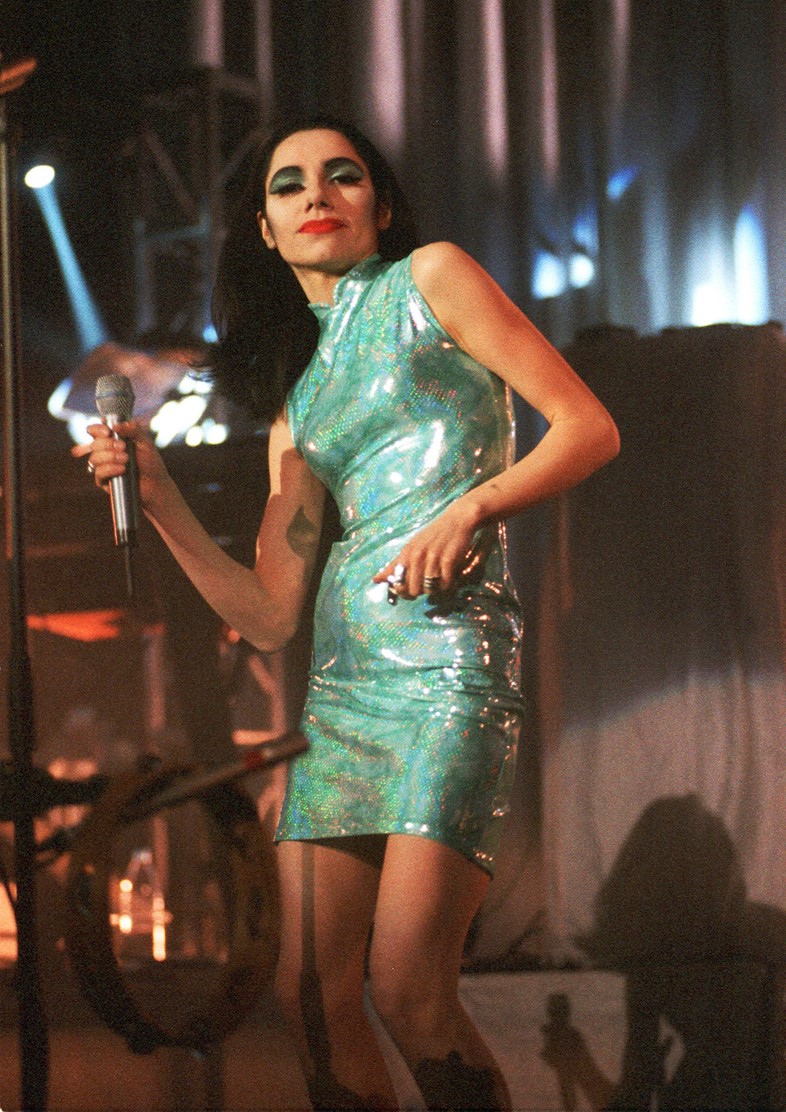PJ Harvey’s Blue Eyeshadow9 Images
This article was originally published in April 2016
True musical icons are multisensory, rearing their heads not just sonically but visually, in dazzling technicolour or with a raw, washed-out grittiness. In the spirit of David Bowie before her, the gods who made PJ Harvey gave us a woman who can do both. What’s more, my first encounter with the enigmatic singer hit my eyes, not my ears.
It was in a copy of Elle Girl, the now-defunct, smarter-than-your-average teen magazine that I used to read religiously around the age of 14. One photo in a feature immediately struck me: a woman with a shaggy black bob, standing legs apart. A camera hung round her wrist, threateningly. She was wearing a worn-in, shrunken t-shirt that could belong to a child, the tiniest gold sequinned miniskirt (the kind you get on market stalls) and a bolt of red lipstick on a wide-set mouth. I immediately cut her out and pasted her by my bed. PJ Harvey.
Looking back, I realise this would have been during Harvey’s Uh Huh Her days: all mini-skirts, boob tubes and stripey socks with kitten heels. But my PJ Harvey fangirling went backwards from there, discovering the freewheeling 90s angst of Dry and Rid of Me before circling to the thrilling, Mercury Music Prize-winning Let England Shake in 2012. Today, as she prepares to confront once again with the release of the politically charged The Hope Six Demolition Project, Harvey is no less uncompromising than she was when I first discovered her. That the personal and political have always been closely intertwined in PJ Harvey’s music goes without saying; but to unpack her female power beyond the discography, we also have to understand her clothes.
It was Harvey’s second act that made the strongest impression: a hyper-femininity that, refusing all that 90s rock knew, set a new benchmark for performance as out-and-out possession
Polly Jean first demanded our attention with a sartorial command: “Put on that dress!”, she cries in “Dress”. “Filthy tight, the dress is filthy!” The first single from the then-trio’s first album, Dry, the lyrical game of dressing and undressing of that song – where Harvey becomes a man, then a woman again – were a harbinger of Harvey’s gender-twisting concerns for the decade to come (see also: the role-switching of “Man-Size”). But unlike her musical power-plays, Harvey’s own look in the early 90s reflected the raw, unfussy aesthetic of her rock peers at the time: make-up-free, scraped-back hair, unshaven armpits and a leather jacket. Controversially posing with a bare back for the NME in 1992, she was as raw as it gets.
But it was Harvey’s second act that made the strongest impression: a hyper-femininity that, refusing all that 90s rock knew, set a new benchmark for performance as out-and-out possession. On a Saturday afternoon in 1995, Harvey performed at Glastonbury Festival in a skintight pink catsuit, sky-high heels, and what would become her signature made-up face: blue eyeshadow, false eyelashes, red lips and eyebrows that just wouldn’t quit. It was a glorious moment that heralded what Harvey would later dub her “Joan Crawford on acid” look, as seen in the video for her creepy breakout single, “Down by the Water”.

For me, looking retrospectively at Harvey’s music, and drinking in her performances on YouTube, this mid-90s phase was unforgettable. I can only imagine the effect it would have had on the generation of women who saw Harvey’s transformations in real time. Standing tall in a gown straight out of golden-era Hollywood, or attending the 1995 MTV music video awards in a push-up bra and skimpy blue dress, Harvey took all the markers of restricted femininity and subverted them – taking them to draggish extremes that challenged the male gaze and asked it, is this what you desire? For Harvey, the darkly visceral realms of human subjectivity and sexuality are always brimming just under the surface – and it was through clothes as well as music that she made those thoughts visible.
In an era that too often asked women to enact their feminism by becoming more like men, Harvey championed an alternative: an amped-up, off-kilter femininity that took everything that women were to be made to feel small for, and made them loud and proud. Girl power belonged to the Spice Girls. Woman power belonged to PJ Harvey, and it was complex and messy. There might be no more prescient symbol of PJ Harvey’s performance of extreme femininity versus the pop-music feminism of the time than one of her later outfits: at Glastonbury in 2004, she wore a top and skirt literally emblazoned with the Spice Girls’ faces, taking their feminism where it could never quite go.
Harvey took all the markers of restricted femininity and subverted them – taking them to draggish extremes that challenged the male gaze and asked it, is this what you desire?
More than anything, PJ Harvey taught me that clothes and make-up don’t hide a woman – they help her conquer. Her whole career, with its many visual transformations, gave a whole new meaning to power-dressing; PJ Harvey as hyper-fem, in particular, presented pop culture with one of its most indelible examples of the power of dressing-up. Did she ever ask us to take her at face value? The answer is, of course, no. But you’re greeted with bright blue lids, heavy eyebrows and a wonky red smile that dares you to, nonetheless.
